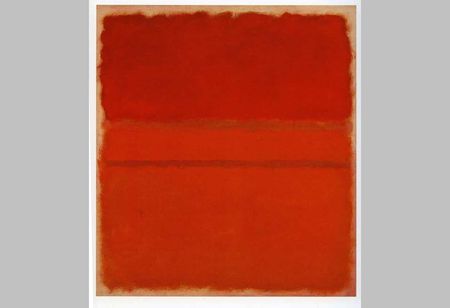"Rothko / Giotto – Tactility in Painting" @ Kulturforum Potsdamer Platz, Gemäldegalerie
Giotto di Bondone (1264-1337), Dormitio Virginis (Marientod), ca. 1310, Eigentum des Kaiser Friedrich-Museums-Vereins. © Staatliche Museen zu Berlin, Gemäldegalerie. Photo: Volker-H. Schneider
BERLIN.- Kulturforum Potsdamer Platz, Gemäldegalerie, presents today Rothko / Giotto – Tactility in Painting, on view through May 3, 2009. An exhibition of the Gemäldegalerie in cooperation with the German Institute of Art History (Max-Planck-Institute) and Daimler Contemporary, Berlin.
Mark Rothko (1903-1970) was one of the primary representatives of Abstract Expressionism of the New York School of Painting. His Color Field Paintings created from the 1950's on, and for which he is famous, are still celebrated today.
Throughout his life, Rothko dealt with philosophic, aesthetical and historiographical issues, by means of which he constantly redefined and questioned his own position as an artist. His ideas have recently been published in "The Artist's Reality" edited by his son Christopher Rothko, but written in the late 1930s. Rothko's thoughts, published in this text, as well as his later works, reveal his involvement with and examination of early Italian painting, particularly that by Giotto di Bondone (1264-1337). His numerous trips to Italy not only allowed him to admire the works of Giotto in situ, but also made him an enthusiast of Fra Angelico.
Regarding Giotto, Rothko was especially interested in his ability to organize space and action by means of color, exemplifying the concept of painted "tactility": Similarly to Giotto, who succeeded in rendering different materials as well as a whole range of human conditions in a tactile way, Rothko tried to intensify his constellations of colors which were to be experienced by the viewer as figurations of action and emotion. Throughout his life, Rothko insisted that he was not an abstract painter. He controlled the hanging of his works and referred to his paintings as "murals", analogical to the Italian technique of fresco painting.
Rothko's involvement with medieval and Renaissance Italian works is the focus point of this exhibition. Thus, the presentation of his canvas "Reds no. 5" (Staatliche Museen zu Berlin, Nationalgalerie, 1961) alongside Giotto's large-sized "Death of the Virgin" (ca. 1310) and his "Crucifixion" (ca. 1315) is meant to lead the viewer to contemplate the relation between the two artists. The relationship between Renaissance and Modern art established in Rothko's thinking and painting is thus the main subject of the exhibition. At the same time, the exhibition space corresponds and relates to Rothko's artistic conception of space: Rothko imagined chapel-like spaces "in which the traveler or wayfarer could contemplate one detail of a painting hanging in a small room".
In 1957 he wrote: "I am interested only in expressing the basic human emotions - tragedy, ecstasy, doom, and so on […].The people who weep before my pictures are having the same religious experience I had when I painted them."
The exhibition is a joint undertaking of the Gemäldegalerie, the German Institute of Art History in Florence (Max Planck-Institute) and Daimler Contemporary, Berlin. The accompanying programme of lectures is sponsored by the Italian Culture Institute, Berlin.
The accompanying catalogue to the exhibition is entitled »Rothko/Giotto« and will be published in German and English (Hirmer). In collaboration with the Visitor Services of the National Museums in Berlin, a film will be offered on hand held devices (free of charge).
Mark Rothko (1903-1970), Reds no. 5, 1961, Staatliche Museen zu Berlin, Neue Nationalgalerie, © VG Bildkunst Bonn, 2008. Photo: Volker-H. Schneider
Giotto di Bondone (1264-1337), Kreuzigung Christi, ca. 1315 © Staatliche Museen zu Berlin, Gemäldegalerie; Foto: Jörg P. Anders

/https%3A%2F%2Fprofilepics.canalblog.com%2Fprofilepics%2F1%2F0%2F100183.jpg)
/https%3A%2F%2Fstorage.canalblog.com%2F03%2F02%2F119589%2F96711876_o.jpg)
/https%3A%2F%2Fstorage.canalblog.com%2F11%2F31%2F119589%2F94773502_o.jpg)
/https%3A%2F%2Fstorage.canalblog.com%2F20%2F83%2F119589%2F94772815_o.jpg)
/https%3A%2F%2Fstorage.canalblog.com%2F26%2F72%2F119589%2F75604929_o.jpg)
/https%3A%2F%2Fstorage.canalblog.com%2F59%2F60%2F119589%2F26458628_o.jpg)





/http%3A%2F%2Fstorage.canalblog.com%2F77%2F91%2F119589%2F129002761_o.jpg)
/http%3A%2F%2Fstorage.canalblog.com%2F05%2F93%2F119589%2F128701538_o.jpg)
/http%3A%2F%2Fstorage.canalblog.com%2F43%2F03%2F119589%2F120591332_o.jpg)
/http%3A%2F%2Fstorage.canalblog.com%2F98%2F10%2F119589%2F120397015_o.jpg)